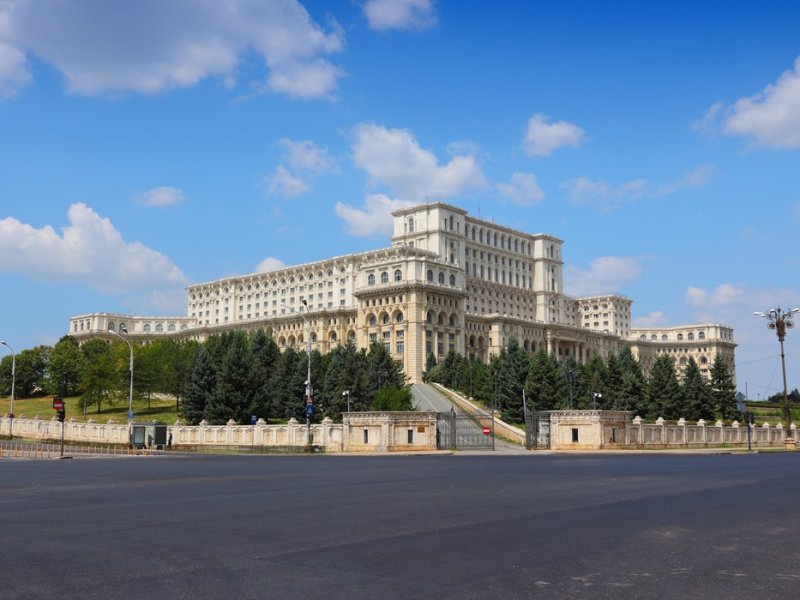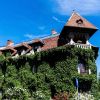The Palace of Parliament, between history and myth: What are the most credible stories about the People’s House?

By Bucharest Team
- Articles
Bucharest’s most emblematic building, the Palace of Parliament (also known as the People’s House), remains one of Romania’s most controversial and fascinating landmarks. Built during the communist era under Nicolae Ceaușescu’s regime, this colossal structure of concrete, marble, and steel has generated numerous legends over the years — some wildly exaggerated, others surprisingly close to the truth.
In this article, we reveal the most credible stories about the Palace of Parliament, separating myths from reality and exploring the mysteries that still surround it.
1. Record-breaking dimensions: fact or hyperbole?
Fact:
- It is the second-largest administrative building in the world, after the Pentagon.
- It has a total built area of 365,000 square meters (larger than Versailles).
- It contains 1,100 rooms, many of which have never been used.
Myth:
- “It has 12 underground levels, including a secret city and tunnels leading all the way to Otopeni Airport.”
Reality: There are indeed underground levels (including a nuclear bunker), but they are not as extensive as the myths suggest. The idea of extremely long tunnels is an exaggeration, although some secret passageways connecting government buildings did exist.
2. “Half of Bucharest was demolished to make room” – How true is this?
Fact:
- For the construction of the Palace and the Civic Center, more than 7,000 houses, 20 churches, and 3 synagogues were demolished.
- The Uranus neighborhood, one of the most picturesque areas of interwar Bucharest, was completely erased from the map.
Myth:
- “All construction materials were 100% Romanian.”
Reality: While the regime promoted this idea, and Rușchița marble was indeed quarried in Romania, some crystals, carpets, and decorative elements were imported.
3. The legend of the church’s “soul” embedded in the structure
The story:
It is said that during the demolitions, an Orthodox church was only partially torn down, and its altar was somehow incorporated into the Palace’s basement.
Credibility:
- Partially true. There were indeed several churches within the construction zone, and some architectural elements (carved stones, fragments of frescoes) were salvaged and relocated. However, there is no clear evidence that an entire altar remains intact beneath the Palace.
4. “It cost so much that it bankrupted the country” – Justified or exaggerated?
Fact:
- The real construction cost is estimated at over €3 billion (in today’s value), draining Romania’s economy in the 1980s.
- Hundreds of thousands of workers (including soldiers) worked in 24-hour shifts, and some died in accidents.
Myth:
- “Ceaușescu wanted to build the tallest palace in the world.”
Reality: Initially, the design did include a taller tower, but engineers persuaded Ceaușescu to abandon the idea due to seismic risks.
5. Ghosts of the Palace: from dead workers to the “lady in white”
Most circulated paranormal stories:
- “Strange noises are heard at night in the empty corridors.”
Explanation: The building’s vast ventilation and duct systems can create unusual echoes. - “A woman in white has been seen in the unused wing.”
Possible origin: The legend likely arose because some dark, isolated sections are rarely accessed by staff.
Conclusion: A symbol of power, sacrifice, and mystery
The Palace of Parliament remains a time capsule — a combination of communist megalomania, engineering ingenuity, and human suffering. Many of the stories surrounding it contain a grain of truth, but others have been amplified by decades of speculation.
What is certain:
- It was built on the ruins of a lost Bucharest.
- It stands as a monument to ambition and excess.
- It still holds unresolved secrets.
If its walls could speak, every room would have a story to tell — some tragic, others merely coincidences turned into legend.
Sources for this article:
- CNSAS Archives (National Council for the Study of the Securitate Archives)
- TVR and BBC documentaries on the Palace’s construction
- Interviews with architects and engineers involved in the project (Gheorghe Leahu, Anca Petrescu)






























